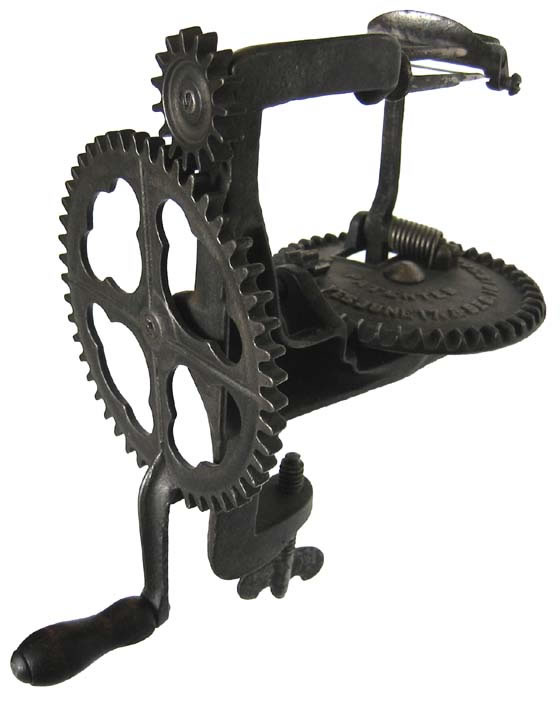|

Keyes
Horatio Keyes (1830-1904)
received the first U.S. patent for a turntable apple parer (Keyes, 1856). Keyes assigned his patent to the firm of Lockey and
Howland c1857 (J. D. Seagrave v H. Keys (sic)). John H. Lockey (1822-1890) and William M. Howland (1817-1874) manufactured the parer embossed with their name and experimented
with at least two designs. Lockey and Howland marketed the machine as the Patent Turn-Table Apple Parer. Lockey bought out Howland in 1866 and continued to make the parers (Emerson, 1888 p. 257). In 1869 D. H. Goodell & Company started manufacturing the Turn-Table Apple Parer. Goodell registered a trade-mark for the term Turn-Table on July 29, 1873 (Thornton, 1997, p. 57).
The parer pictured above is marked PATENTED BY H.
KEYES JUNE 17 & DEC. 16, 1856. Turn
the hand-driven gear and a fork gear rotates the apple. A small table
gear rotating with the
hand-driven gear moves the turntable gear, which carries the paring
arm around the apple. Once the apple is pared an incline on the parer
frame or cam pushes the paring arm away as it swings back to its original position.
Visit the Evolution section of our website to learn more about this parer.
|
References
Emerson, W. A. 1888. Leominster Massachusetts Historical and Picturesque. Gardner, Massachusetts, Lithotype Publishing Co.
J. D. Seagrave v Keys (sic), Interference File for patent 16240, National Archives Kansas City, Missouri.
Keyes, H., inventor; 1856 June 17. Machine for Paring Apples. US15133.
Keyes, H., inventor; 1856 Dec. 16. Machine for Paring Apples. US16240.
Thornton, D. 1997. Apple Parers. Sunnyvale, California: Off Beat Books. |

